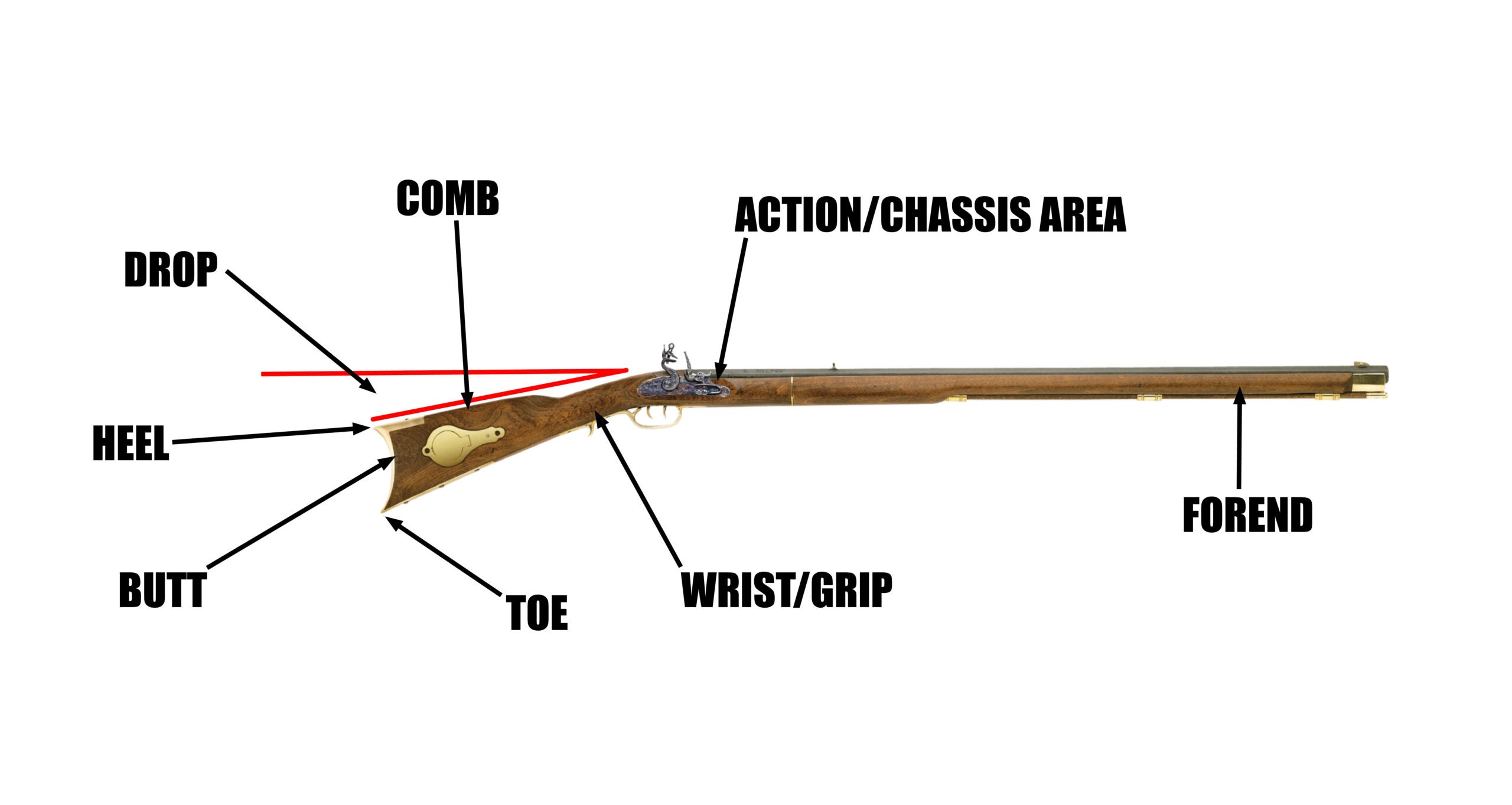



When it comes to the stock of a rifle there are primarily three elements or areas of the stock that are important. These are the forend, grip or wrist, and the butt, and together they determine how you interface with the rifle. But just as important, the configuration of these elements and how they intertwine, determine the practical application of the rifle. Here’s a basic guide to the stock of a rifle and how to pick the right stock style for how you hunt.


The best way describe how rifle stocks came to look the way they do is to go back to the beginning and look at traditional muzzleloading rifles and how their stocks were configured. These rifles were designed to be shot almost exclusively off-hand. Because of that, their stocks were slim and trim from the toe to the tip of the forend. This helped shooters comfortably hold these rifles. The sharp toe of the stock sort of hooked under the arm to support the weight of the long barrel, and the forend was narrow to comfortably fit the support hand. Maybe most important, the comb was low–and had a lot of drop—to properly align the shooter’s eye with the sights, while at the same time allowing for a good cheek weld.
With the first lever action rifles the stock of the rifle remained very similar, except that the butt stock and forend became two pieces. It wasn’t until the bolt action repeating rifle and the advent of optical sights that we began to see some real changes in rifle stock configuration. That’s when rifle stocks started becoming a bit more robust, and it’s also when the amount of drop at the comb began to decrease to allow for a cheek weld that would offer a compromise between fixed sights and riflescopes. Another change we began to see was a more curved grip or wrist to make the positioning of the shooting hand more comfortable when addressing the trigger.
From around the time of the second World War up until the close of the 20th century, rifle stocks on hunting rifles remained largely unchanged. The common design shape was considered a sporting stock, and though there were some variances, the general configuration was similar across most brands. The next change we began to see was the introduction of rifle stocks that were more ideally adapted to target shooting. These stocks were even more robust. The forends were wider and often flat on the bottom to better interface with sandbags, and the comb of the buttstock had even less drop because these types of rifles were not outfitted with fixed sights. It was at around this time that synthetics became a very popular material for stocks.

Moving into the 21st Century another type of rifle stock began to emerge. This was the chassis stock, which was partly influenced by the modularity of the AR15, but the design was also driven by the extreme interest in long-range/precision shooting. With a chassis-stocked rifle, like the Bergara Premier MGLite, the forend, buttstock, and grip are all modular. This opens the door for the use of a variety of stock materials and for extreme versatility that includes adjustments to the buttstock so that it could be tuned to better interface with the shooter. It also allowed for stock forends to include rails and other mounting systems that were compatible with bipods and tripods.
Hunters have a lot of choices when it comes to rifle stocks. Most rifle manufacturers offer a variety to choose from and the aftermarket rifle stock market is flooded with options. But how can you decide which style of rifle stock is best for you and the way you hunt? Well, it’s not as complicated as you might imagine, and it all starts with how the rifle stock fits you.

Fit matters because we are all different sizes, have arms of different lengths, and faces and necks of different shapes. Fit determines how you interface with your rifle, so you best get it right. You can start with the length of pull (LOP), which is the distance from the end of the butt stock to the trigger. The standard LOP on the stock of a rifle is about 13 inches, which is about right for a six-foot-tall man. To determine your LOP, measure from the inside of your bent elbow to the bend in your trigger finger. But this is not an exact science. I’m six foot one, and my LOP measures 13 inches. However, I’m more comfortable with a LOP of about 12.5 to 12.75 inches. In fact, I’ve found most shooters perform better with a LOP about a ½-inch shorter than the referenced measurement would suggest. This is why gunsmiths make a living shortening stocks. and it’s why many modern rifle stocks have an adjustable length of pull.
The next area that needs to be checked is comb height. If you’re going to be shooting with open sights, the comb needs to be low with a drop of about 0.5 to 1.5 inches, depending on sight height and rifle configuration. If you’re going to be using a conventional-sized riflescope, you’ll want the drop to be somewhere between -0.5 and +0.5 inches, so you can maintain a good cheek weld and see through the scope. A rifle like the Kimber Caprivi, which is intended for dangerous game, has minimal drop to work with a conventional riflescope, but it also has iron sights that are mounted a bit high. This allows the hunter to choose between the two. However, if you plan to use a large, long-range hunting scope that will need to be mounted higher, you’re probably going to need a more modern-style stock with an adjustable comb height.

The grip on the stock of a rifle matters too. An open grip with minimal curvature, like those found on early bolt-action rifle stocks or lever guns, is more conducive to a rifle you’ll want to handle quickly. But as the type of shooting you do transitions from off-hand to shooting from a rest and especially from the prone position, a straighter grip will suit you better. When it comes to the forend of the rifle stock, a leaner and trimer forend is more comfortable and better suited to off-hand shooting. And like we saw at the turn of the last century, wider and flatter forends work better from sandbags and are more adaptable to bipods and tripods.
Read Next: The 7 Essential Traits of a Great Hunting Rifle
Fortunately, many modern bolt action hunting rifles are now offered with sort of a hybrid forend and stock. They do a good job of melding a mixture of the old and new, and this allows the hunter more versatility. The stocks, like you’ll find on rifles like the Springfield Model 2020 Waypoint, the Ruger Long Range Hunter, and the Bergara HMR Carbon, offer hunters a versatile package for a wider range of applications. There’s not really a single rifle stock that’s best, there are rifle stocks that are better for certain applications. The key is finding one that fits your body, shooting style, and the way you hunt.

